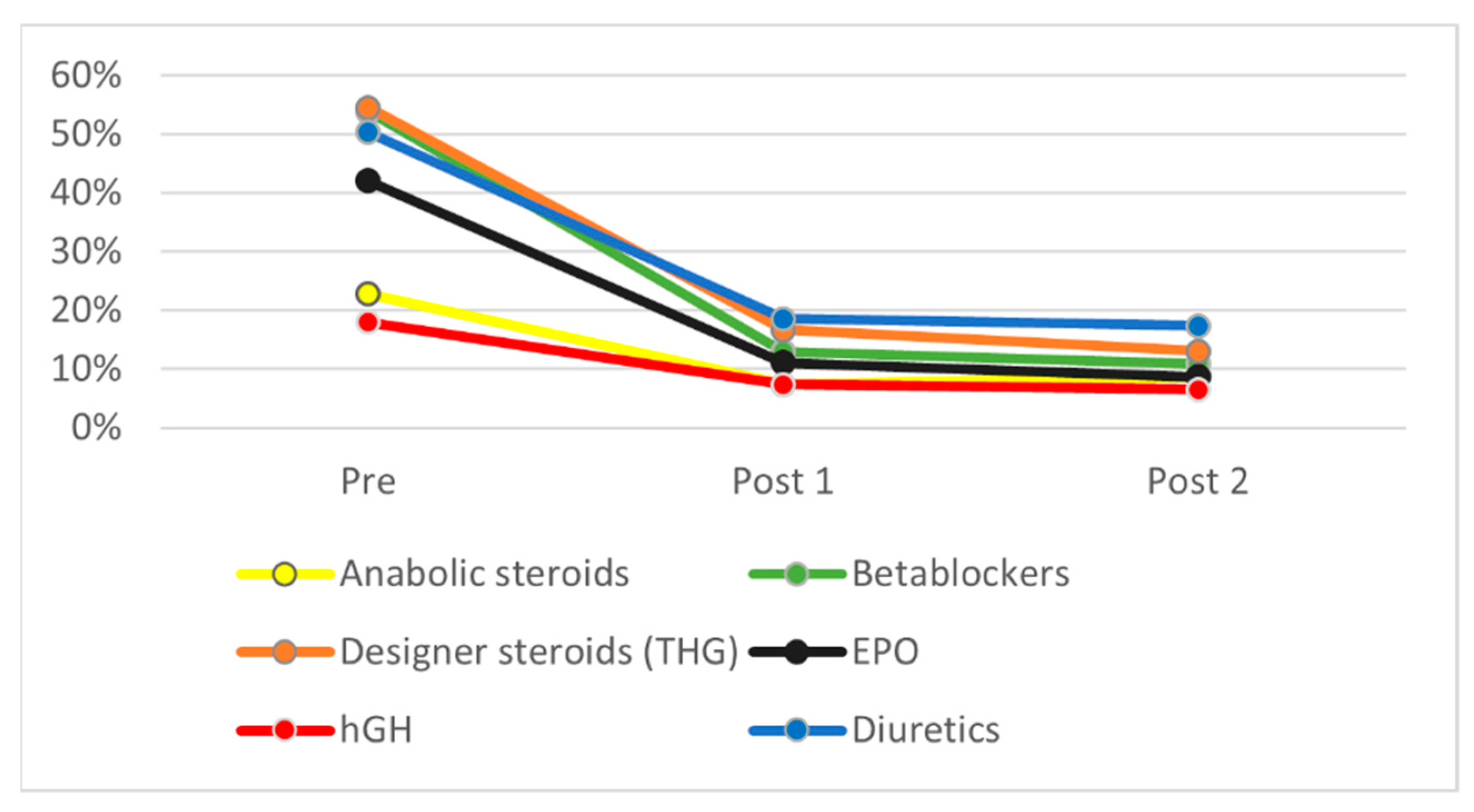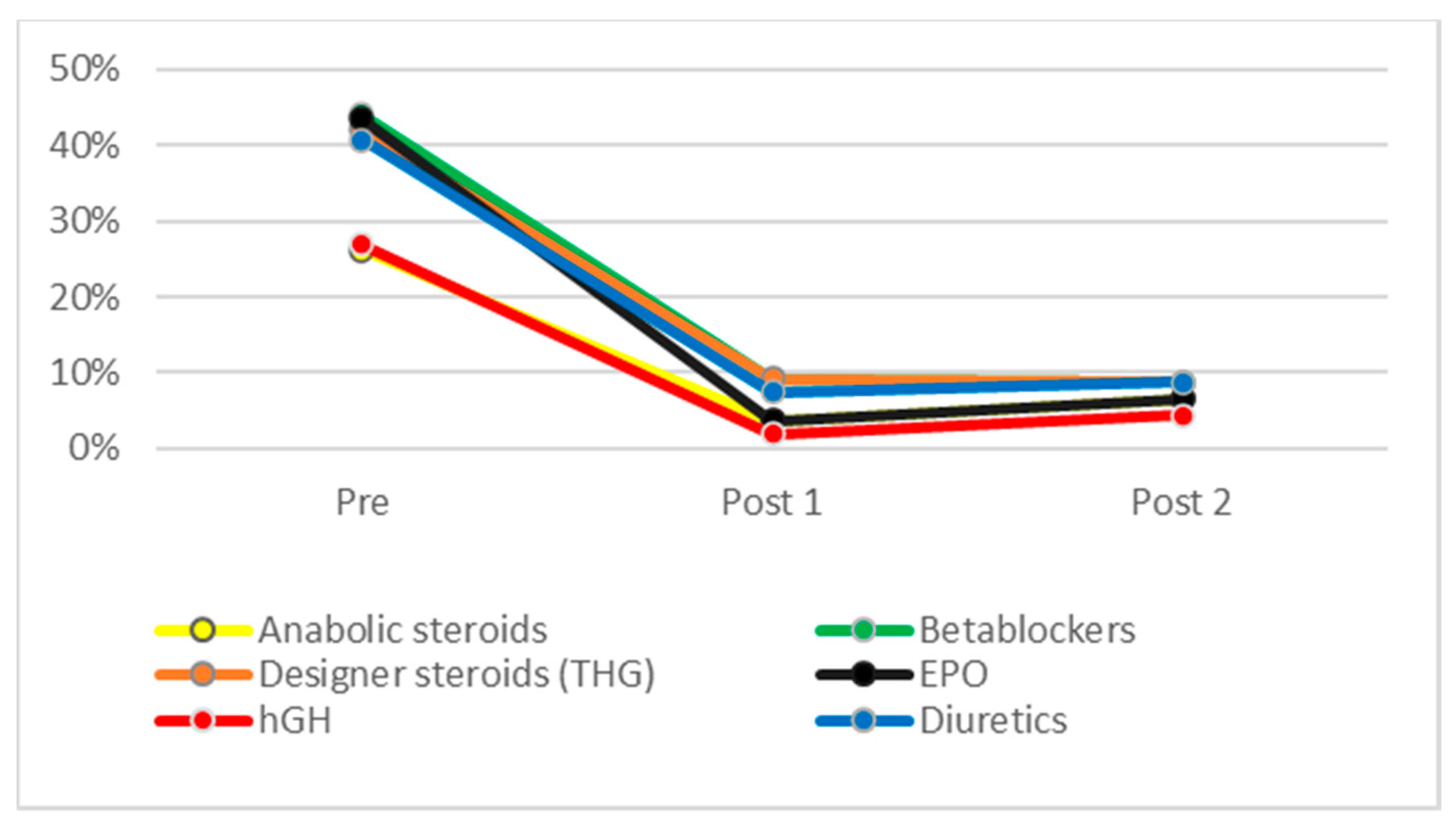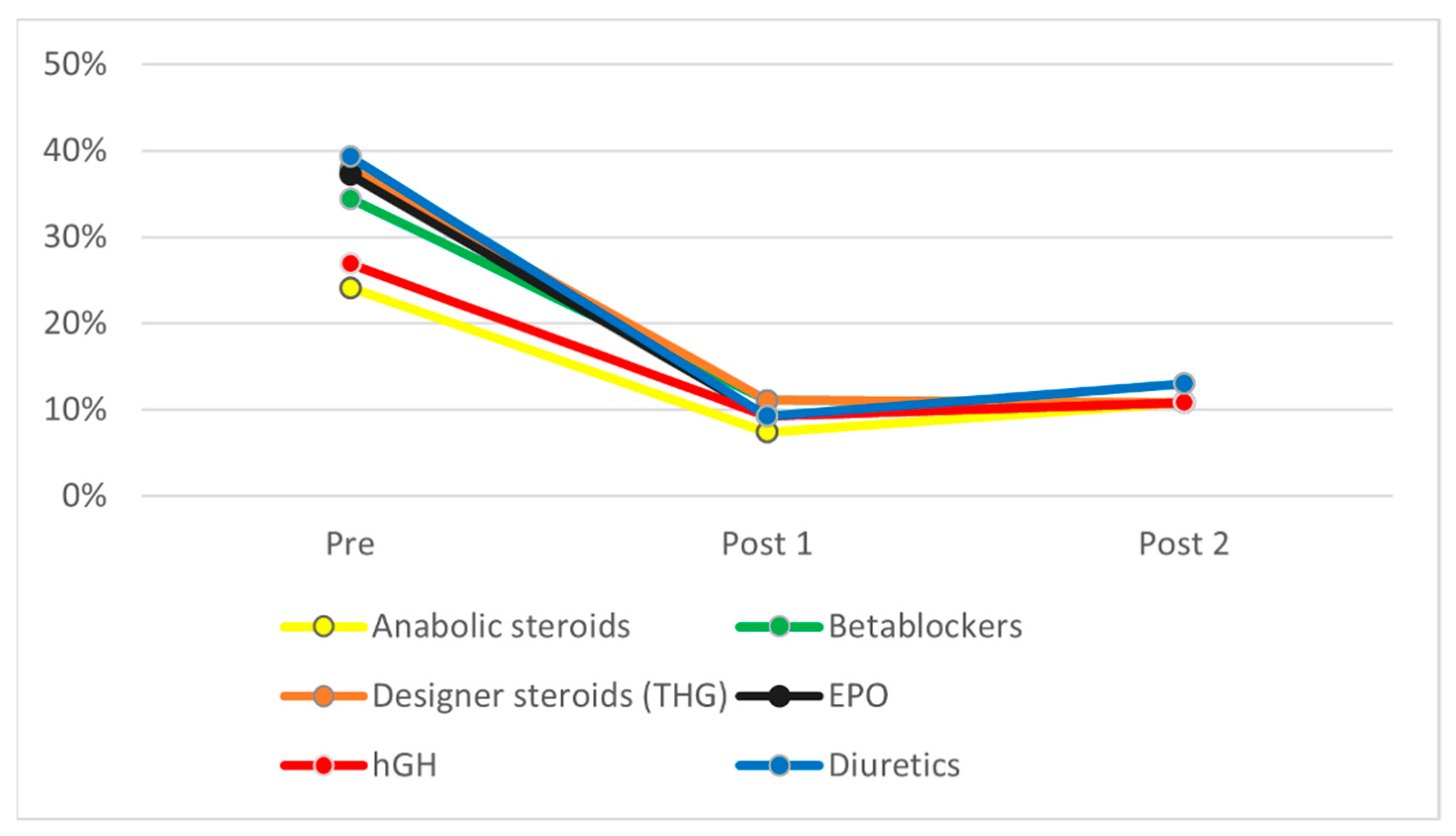Study of an Anti-Doping Education Program in Spanish Sports Sciences Students
Abstract
1. Introduction
2. Materials and Methods
3. Results
3.1. Effects of the Educational Program on Knowledge of PES Use
3.2. Effects of the Educational Program on Morality
4. Discussion
4.1. Perceived Knowledge
4.2. Moral Judgment
5. Conclusions
6. Limitations
Author Contributions
Funding
Institutional Review Board Statement
Informed Consent Statement
Data Availability Statement
Acknowledgments
Conflicts of Interest
References
- Mountjoy, M.; Junge, A. The role of International Sport Federations in the protection of the athlete’s health and promotion of sport for health of the general population. Br. J. Sports Med. 2013, 47, 1023–1027. [Google Scholar] [CrossRef] [PubMed]
- Houlihan, B.; Vidar Hanstad, D.; Loland, S.; Waddington, I. The World Anti-Doping Agency at 20: Progress and challenges. Int. J. Sport Policy Politics 2019, 11, 193–201. [Google Scholar] [CrossRef]
- de Hon, O.; Kuipers, H.; Van Bottenburg, M. Prevalence of Doping Use in Elite Sports: A Review of Numbers and Methods. Sports Med. 2015, 45, 57–69. [Google Scholar] [CrossRef] [PubMed]
- Ulrich, R.; Pope, H.G.; Cléret, L.; Petróczi, A.; Nepusz, T.; Schaffer, J.; Kanayama, G.; Comstock, R.D.; Simon, P. Doping in Two Elite Athletics Competitions Assessed by Randomized-Response Surveys. Sports Med. 2018, 48, 211–219. [Google Scholar] [CrossRef] [PubMed]
- Blank, C.; Brunner, J.; Kreische, B.; Lazzeri, M.; Schobersberger, W.; Kopp, M. Performance-enhancing substance use in university students: Motives, attitudes, and differences in normative beliefs. J. Subst. Use 2017, 22, 324–330. [Google Scholar] [CrossRef]
- Backhouse, S.; Whitaker, L.; Patterson, L.; Erickson, K.; McKenna, J. Social Psychology of Doping in Sport: A Mixed-Studies Narrative synthesis; World Anti-Doping Agency: Montreal, QC, Canada, 2016. [Google Scholar]
- Ntoumanis, N.; Ng, J.; Barkoukis, V.; Backhouse, S.H. Personal and Psychosocial Predictors of Doping Use in Physical Activity Settings: A Meta-Analysis. Sports Med. 2014, 44, 1603–1624. [Google Scholar] [CrossRef]
- Kavussanu, M.; Ring, C. Moral Identity Predicts Doping Likelihood via Moral Disengagement and Anticipated Guilt. J. Sport Exerc. Psychol. 2017, 39, 293–301. [Google Scholar] [CrossRef] [PubMed]
- Ring, C.; Kavussanu, M. The role of self-regulatory efficacy, moral disengagement and guilt on doping likelihood: A social cognitive theory perspective. J. Sports Sci. 2018, 36, 578–584. [Google Scholar] [CrossRef]
- Stanger, N.; Backhouse, S.H. A Multistudy Cross-Sectional and Experimental Examination into the Interactive Effects of Moral Identity and Moral Disengagement on Doping. J. Sport Exerc. Psychol. 2020, 42, 185–200. [Google Scholar] [CrossRef]
- Aquino, K.; Americus, R. The self-importance of moral identity. J. Pers. Soc. Psychol. 2002, 83, 1423–1440. [Google Scholar] [CrossRef]
- Kohlberg, L. From is to ought: How to commit the naturalistic fallacy and get away with it in the study of moral development. In Cognitive Development and Epistemology; Mischel, T., Ed.; Academic Press: Cambridge, MA, USA, 1971; pp. 164–165. [Google Scholar]
- Bandura, A. Self-Efficacy: The Exercise Of Control; W.H. Freeman: New York, NY, USA, 2012. [Google Scholar]
- Sukys, S.; Tilindiene, I.; Majauskiene, D.; Karanauskiene, D. Moral identity and attitudes towards doping in sport: Whether perception of fair play matters. Int. J. Environ. Res. Public Health 2021, 18, 11531. [Google Scholar] [CrossRef] [PubMed]
- Kavussanu, M.; Yukhymenko-Lescroart, M.A.; Elbe, A.-M.; Hatzigeorgiadis, A. Integrating moral and achievement variables to predict doping likelihood in football: A cross-cultural investigation. Psychol. Sport Exerc. 2020, 47, 101518. [Google Scholar] [CrossRef]
- Bandura, A. Moral Disengagement in the Perpetration of Inhumanities. Pers. Soc. Psychol. Rev. 1999, 3, 193–209. [Google Scholar] [CrossRef] [PubMed]
- Kavussanu, M.; Stanger, N.; Ring, C. The effects of moral identity on moral emotion and antisocial behavior in sport. Sport Exerc. Perform. Psychol. 2015, 4, 268–279. [Google Scholar] [CrossRef]
- Sage, L.; Kavussanu, M.; Duda, J. Goal orientations and moral identity as predictors of prosocial and antisocial functioning in male association football players. J. Sports Sci. 2006, 24, 455–466. [Google Scholar] [CrossRef]
- Donovan, R.J.; Egger, G.; Kapernick, V.; Mendoza, J. A conceptual framework for achieving performance enhancing drug compliance in sport. Sports Med. 2002, 32, 269–284. [Google Scholar] [CrossRef]
- Ring, C.; Kavussanu, M.; Simms, M.; Mazanov, J. Effects of situational costs and benefits on projected doping likelihood. Psychol. Sport Exerc. 2018, 34, 88–94. [Google Scholar] [CrossRef]
- Lentillon-Kaestner, V.; Hagger, M.S.; Hardcastle, S. Health and doping in elite-level cycling. Scand J. Med. Sci. Sports 2012, 22, 596–606. [Google Scholar] [CrossRef]
- Ozkan, O.; Torgutalp, S.S.; Kara, O.S.; Donmez, G.; Demire, H.; Karanfil, Y.; Yargic, M.P.; Korkusuz, F. Doping Knowledge and Attitudes of Turkish Athletes: A Cross-Sectional Study. Montenegrin J. Sports Sci. Med. 2020, 9, 49–55. [Google Scholar] [CrossRef]
- Orr, R.; Grassmayr, M.; Macniven, R.; Grunseit, A.; Halaki, M.; Bauman, A. Australian athletes’ knowledge of the WADA Prohibited Substances List and performance enhancing substances. Int. J. Drug Policy 2018, 56, 40–45. [Google Scholar] [CrossRef]
- Bates, G.; Begley, E.; Tod, D.; Jones, L.; Leavey, C.; McVeigh, J. A systematic review investigating the behavior change strategies in interventions to prevent misuse of anabolic steroids. J. Health Psychol. 2019, 24, 1595–1612. [Google Scholar] [CrossRef] [PubMed]
- Kavussanu, M.; Hurst, P.; Yukhymenko-Lescroart, M.; Galanis, E.; King, A.; Hatzigeorgiadis, A.; Ring, C. A moral intervention reduces doping likelihood in British and Greek athletes: Evidence from a cluster randomized control trial. J. Sport Exerc. Psychol. 2021, 43, 125–139. [Google Scholar] [CrossRef] [PubMed]
- Barkoukis, V.; Kartali, K.; Lazuras, L.; Tsorbatzoudis, H. Evaluation of an anti-doping intervention for adolescents: Findings from a school-based study. Sport Manag. Rev. 2016, 19, 23–34. [Google Scholar] [CrossRef]
- Lucidi, F.; Mallia, L.; Alivernini, F.; Chirico, A.; Manganelli, S.; Galli, F.; Biasi, V.; Zelli, A. The Effectiveness of a New School-Based Media Literacy Intervention on Adolescents’ Doping Attitudes and Supplements Use. Front. Psychol. 2017, 8, 749. [Google Scholar] [CrossRef] [PubMed]
- Gatterer, K.; Gumpenberger, M.; Overbye, M.; Streicher, B.; Schobersberger, W.; Blank, C. An evaluation of prevention initiatives by 53 national anti-doping organizations: Achievements and limitations. J. Sport Health Sci. 2020, 9, 228–239. [Google Scholar] [CrossRef]
- World Anti-Doping Agency. International Standard for Education; World Anti-Doping Agency: Montreal, QC, Canada, 2021. [Google Scholar]
- Blank, C.; Kopp, M.; Niedermeier, M.; Schnitzer, M.; Schobersberger, W. Predictors of doping intentions, susceptibility, and behavior of elite athletes: A meta-analytic review. SpringerPlus 2016, 5, 1–14. [Google Scholar] [CrossRef]
- Mazanov, J.; Backhouse, S.; Connor, J.; Hemphill, D.; Quirk, F. Athlete support personnel and anti-doping: Knowledge, attitudes, and ethical stance. Scand J. Med. Sci. Sports 2014, 24, 846–856. [Google Scholar] [CrossRef]
- Patterson, L.B.; Backhouse, S.H.; Duffy, P.J. Anti-doping education for coaches: Qualitative insights from national and international sporting and anti-doping organisations. Sport Manag. Rev. 2016, 19, 35–47. [Google Scholar] [CrossRef]
- Patterson, L.B.; Backhouse, S.H. “An important cog in the wheel”, but not the driver: Coaches’ perceptions of their role in doping prevention. Psychol. Sport Exerc. 2018, 37, 117–127. [Google Scholar] [CrossRef]
- Vangrunderbeek, H.; Tolleneer, J. Student attitudes towards doping in sport: Shifting from repression to tolerance? Int. Rev. Sociol. Sport 2011, 46, 346–357. [Google Scholar] [CrossRef]
- Takahashi, M.; Tatsugi, Y.; Kohno, T. Investigacion of the Attitudes of Japanese Physical Educational University Students toward Doping in Sports. J. Sports Med. Doping Stud. 2013, 3, 122. [Google Scholar] [CrossRef]
- Morente-Sánchez, J.; Freire-SantaCruz, C.; Mateo-March, M.; Zabala, M. Attitude towards doping in Spanish Sport Sciences university students according to the type of sport practised: Individual versus team sports. Sci. Sports 2015, 30, 96–100. [Google Scholar] [CrossRef]
- Puchades, M.; Molina, P. Attitudes Towards Doping among Sport Sciences Students. Apunts. Educ. Fís. Deporte 2020, 140, 1–7. [Google Scholar] [CrossRef]
- Poussel, M.; Laure, P.; Latarche, C.; Laroppe, J.; Schwitzer, M.; Koch, J.-P.; Heid, J.-M.; Chenuel, B. Specific teaching about doping in sport helps medical students to meet prevention needs. Sci. Sports 2013, 28, 274–280. [Google Scholar] [CrossRef]
- Hellison, D. Teaching Responsibility through Physical Education; Human Kinetics Publishers: Champaign, IL, USA, 1995. [Google Scholar]
- Shen, Y.; Martinek, T.; Dyson, B.P. Navigating the Processes and Products of The Teaching Personal and Social Responsibility Model: A Systematic Literature Review. Quest 2022, 74, 91–107. [Google Scholar] [CrossRef]
- Donovan, R.J.; Jalleh, G.; Gucciardi, D.F. Research Package for Anti-Doping Organizations; World Anti-Doping Agency: Montreal, QC, Canada, 2015. [Google Scholar]
- García-Grimau, E.; De la Vega, R.; De Arce, R.; Casado, A. Attitudes Toward and Susceptibility to Doping in Spanish Elite and National-Standard Track and Field Athletes: An Examination of the Sport Drug Control Model. Front. Psychol. 2021, 12, 679001. [Google Scholar] [CrossRef]
- Donovan, R.J. Towards an understanding of factors influencing athletes’ attitudes towards performance enhancing technologies: Implications for ethics education. In Performance-Enhancing Technologies in Sport: Ethical, Conceptual and Scientific Issues; Maschke, K.J., Murray, T.H., Wasunna, A.A., Eds.; Johns Hopkins University Press: Baltimore, MA, USA, 2009; pp. 283–317. [Google Scholar]
- Aguilar-Navarro, M.; Salas-Montoro, J.-A.; Pino-Ortega, J.; Salinero, J.J.; González-Mohíno, F.; Alcaraz-Rodríguez, V.; Moreno-Pérez, D.; Lanza, N.; Lara, B.; Moreno-Pérez, V.; et al. Anti-Doping Knowledge of Students Undertaking Bachelor’s Degrees in Sports Sciences in Spain. Nutrients 2022, 14, 4523. [Google Scholar] [CrossRef]
- Blank, C.; Flatscher-Thöni, M.; Gatterer, K.; Happ, E.; Schobersberger, W.; Stühlinger, V. Doping Sanctions in Sport: Knowledge and Perception of (Legal) Consequences of Doping—An Explorative Study in Austria. J. Risk Financ. Manag. 2021, 14, 603. [Google Scholar] [CrossRef]
- Hurst, P.; Ring, C.; Kavussanu, M. An evaluation of UK athletics’ clean sport programme in preventing doping in junior elite athletes. Perform. Enhanc. Health 2020, 7, 100155. [Google Scholar] [CrossRef]
- Chirico, A.; Lucidi, F.; Pica, G.; Di Santo, D.; Galli, F.; Alivernini, F.; Mallia, L.; Zelli, A.; Kruglanski, A.W.; Pierro, A. The Motivational Underpinnings of Intentions to Use Doping in Sport: A Sample of Young Non-Professional Athletes. Int. J. Environ. Res. Public Health 2021, 18, 5411. [Google Scholar] [CrossRef]
- Nicholls, A.R.; Morley, D.; Thompson, M.A.; Huang, C.; Abt, G.; Rothwell, M.; Cope, E.; Ntoumanis, N. The effects of the iPlayClean education programme on doping attitudes and susceptibility to use banned substances among high-level adolescent athletes from the UK: A cluster-randomised controlled trial. Int. J. Drug Policy 2020, 82, 102820. [Google Scholar] [CrossRef] [PubMed]



| Phase | Aims | Content |
|---|---|---|
| Phase 1: 1 h, introductory online seminar | Introduction to the course | Sports values and their relationship with fair play and doping prevention. |
| Phase 2: 25 h online course | ||
| Unit 1: Doping | Teaching the main features of the anti-doping regulation | History and definition of doping. Regulations and a list of prohibited substances and methods in sports. Consequences of doping. Prevention of unintentional doping. |
| Unit 2: Doping psychological variables | Train students on the psychological factors as well as the periods of greatest risk and vulnerability. | Education in values. Assertiveness and the decision-making process. Risk and protective factors. The different roles in prevention: sources of influence. Points of intervention in situations of doping temptation. Assessment of vulnerability and attitudes. |
| Phase 3: 1 h live online seminar | To train students into using the TPSRM in doping scenarios | The 4 key competencies of the sports educator are to promote a culture of learning and fair play in the group. The 5 levels of the Personal and Social Responsibility Program. The 9 methodological strategies of the sports educator promote positive development and healthy habits. Structure and organization of a session to integrate personal and social responsibility and promote positive development through sport. |
| PRE | POST1 | POST2 | |||||||||||||
|---|---|---|---|---|---|---|---|---|---|---|---|---|---|---|---|
| Yes | No | Yes | No | Yes | No | ||||||||||
| N | % | N | % | N | % | N | % | N | % | N | % | χ2 | p | µ2 | |
| Knowledge PES use—performance effects | |||||||||||||||
| Anabolic steroids | 112 | 77.2 | 33 | 22.8 | 50 | 92.6 | 4 | 7.4 | 42 | 91.3 | 4 | 8.7 | 9,28 | 0.01 | 0.195 |
| Beta blockers | 67 | 46.2 | 78 | 53.8 | 47 | 87 | 7 | 13 | 41 | 89.1 | 5 | 10.9 | 44.53 | 0.001 | 0.426 |
| Designer steroids (THG) | 66 | 45.5 | 79 | 54.5 | 45 | 83.3 | 9 | 16.7 | 40 | 87 | 6 | 13 | 39.15 | 0.001 | 0.400 |
| EPO | 84 | 57.9 | 61 | 42.1 | 48 | 88.9 | 6 | 11.1 | 42 | 91.3 | 4 | 8.7 | 29.64 | 0.001 | 0.348 |
| hGH | 119 | 82.1 | 26 | 17.9 | 50 | 92.6 | 4 | 7.4 | 43 | 93.5 | 3 | 6.5 | 6.08 | 0.048 | 0.158 |
| Diuretics | 72 | 49.7 | 73 | 50.3 | 44 | 81.5 | 10 | 18.5 | 38 | 82.6 | 8 | 17.4 | 26.54 | 0.001 | 0.329 |
| Knowledge PES use—long-term effects | |||||||||||||||
| Anabolic steroids | 110 | 75.9 | 35 | 24.1 | 50 | 92.6 | 4 | 7.4 | 41 | 89.1 | 5 | 10.9 | 9.40 | 0.009 | 0.196 |
| Beta blockers | 95 | 65.5 | 50 | 34.5 | 48 | 88.9 | 6 | 11.1 | 41 | 89.1 | 5 | 10.9 | 17.45 | 0.001 | 0.267 |
| Designer steroids (THG) | 90 | 61.1 | 55 | 37.9 | 48 | 88.9 | 6 | 11.1 | 41 | 89.1 | 5 | 10.9 | 21.81 | 0.001 | 0.298 |
| EPO | 91 | 62.8 | 54 | 37.2 | 49 | 90.7 | 5 | 9.3 | 41 | 89.1 | 5 | 10.9 | 22.79 | 0.001 | 0.305 |
| hGH | 106 | 73.1 | 39 | 26.9 | 49 | 90.7 | 5 | 9.3 | 41 | 89.1 | 5 | 10.9 | 10.60 | 0.005 | 0.108 |
| Diuretics | 88 | 60.7 | 57 | 39.3 | 49 | 90.7 | 5 | 9.3 | 40 | 87 | 6 | 13 | 23.83 | 0.001 | 0.312 |
| Knowledge PES use—short-term effects | |||||||||||||||
| Anabolic steroids | 107 | 73.8 | 38 | 26.6 | 52 | 96.3 | 2 | 3.7 | 43 | 93.5 | 3 | 6.5 | 18.53 | 0.001 | 0.275 |
| Beta blockers | 81 | 55.9 | 64 | 44.1 | 49 | 90.7 | 5 | 9.3 | 42 | 91.3 | 4 | 8.7 | 34.94 | 0.001 | 0.378 |
| Designer steroids (THG) | 84 | 57.9 | 61 | 42.1 | 49 | 90.7 | 5 | 9.3 | 42 | 91.3 | 4 | 8.7 | 31.72 | 0.001 | 0.360 |
| EPO | 82 | 56.6 | 63 | 43.4 | 52 | 96.3 | 2 | 3.7 | 43 | 93.5 | 3 | 6.5 | 43.73 | 0.001 | 0.422 |
| hGH | 106 | 73.1 | 39 | 26.9 | 53 | 98.1 | 1 | 1.9 | 44 | 95.7 | 2 | 4.3 | 23.90 | 0.001 | 0.312 |
| Diuretics | 86 | 59.3 | 59 | 40.7 | 50 | 92.6 | 4 | 7.4 | 42 | 91.3 | 4 | 8.7 | 31.85 | 0.001 | 0.361 |
Publisher’s Note: MDPI stays neutral with regard to jurisdictional claims in published maps and institutional affiliations. |
© 2022 by the authors. Licensee MDPI, Basel, Switzerland. This article is an open access article distributed under the terms and conditions of the Creative Commons Attribution (CC BY) license (https://creativecommons.org/licenses/by/4.0/).
Share and Cite
García-Martí, C.; Ospina-Betancurt, J.; Asensio-Castañeda, E.; Chamorro, J.L. Study of an Anti-Doping Education Program in Spanish Sports Sciences Students. Int. J. Environ. Res. Public Health 2022, 19, 16324. https://doi.org/10.3390/ijerph192316324
García-Martí C, Ospina-Betancurt J, Asensio-Castañeda E, Chamorro JL. Study of an Anti-Doping Education Program in Spanish Sports Sciences Students. International Journal of Environmental Research and Public Health. 2022; 19(23):16324. https://doi.org/10.3390/ijerph192316324
Chicago/Turabian StyleGarcía-Martí, Carlos, Jonathan Ospina-Betancurt, Eva Asensio-Castañeda, and José L. Chamorro. 2022. "Study of an Anti-Doping Education Program in Spanish Sports Sciences Students" International Journal of Environmental Research and Public Health 19, no. 23: 16324. https://doi.org/10.3390/ijerph192316324
APA StyleGarcía-Martí, C., Ospina-Betancurt, J., Asensio-Castañeda, E., & Chamorro, J. L. (2022). Study of an Anti-Doping Education Program in Spanish Sports Sciences Students. International Journal of Environmental Research and Public Health, 19(23), 16324. https://doi.org/10.3390/ijerph192316324







